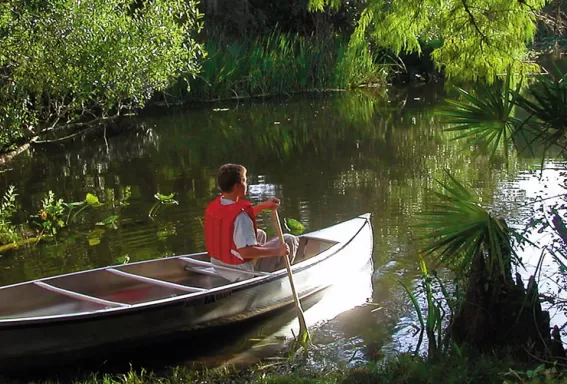Tips for Photographing Wildlife
It has never been easier to capture images of wildlife from a kayak than it is on the Great Calusa Blueway Paddling Trail.
With more than 300 species of birds living here or migrating through, the plumage and colors are amazing. The trail’s route passes through habitat that varies from mangrove tunnels and sandy shorelines to banks of cypress, cabbage palms and moss-draped oaks.
Back bays teem with wildlife and photo ops. Dolphins often playfully approach kayakers; manatees surface at your stern and sometimes rub their hairy noses on your paddle blade.
Get the Shots
- For best results as a shutterbug from your boat, consider these tips garnered from professional photographers and avid kayakers:
- Attach a bungee cord or strap to your paddle. When you’re absorbed in your camerawork, your paddle could slip away.
- Observe wildlife from a safe distance. Use your lens to improve your view. Watch for signs that birds and other animals are getting agitated.
- Carry a towel or a shammy cloth to keep your lens clear and dry.
- Consider bringing a monopod to keep your camera steady.
- Bring a small anchor or a stake to keep your boat in place while you shoot.
- Carry a dry sack. When paddling, keep gear handy with the camera ready to pull out quickly.
- Paddle in early morning or near sunset for better light and more wildlife sightings.
What You'll Find
Any creature can be enchanting in a photo, from still oysters to darting dragonflies. Here’s information and how-to’s for often-photographed wildlife on the Blueway:
Dolphins: Southwest Florida is home to one of the highest concentrations of bottlenose dolphins in the world. Flipper most likely will find you before you find him. Spring and summer offer exceptional times to photograph mothers with their young. Adults can be seen teaching the youngsters how to round up fish.
Best bet: Open water in Pine Island Sound and Matlacha Pass
Manatees: These lumbering sea cows are experts at appearing and sinking below the water’s surface so quickly, you miss the shot. They also are difficult to see because their color matches the tannin of our mangrove-laced waters. Tip: Wear polarized sunglasses. You’ll have a better chance to see the manatees before they rise to the surface, so you can have your camera ready.
Best bet: Orange River and inland Caloosahatchee River during cooler winter months
Ospreys: These fish hawks love to nest atop channel markers and other pilings. Their young’s fuzzy heads start appearing in spring, offering Hallmark shots. Tip: If you’re shooting a nest atop a channel marker, take care to not drift into the powerboat channel.
Best bet: Just about anywhere
Pelicans: Brown pelicans live in Lee County year ’round. White pelicans migrate in for winter and spring.
Best bet: Fishing piers and pilings for brown pelicans – the white-headed ones with touches of yellow are males; the brown ones are females. White pelicans can usually be seen in January, February or March. They are not solitary like brown pelicans and can be seen in flocks of 30 or 40.
Herons and egrets: Low tide is the time to go if you want to see these birds feed. Name it and it probably lives here – yellow-crowned night herons, black-crowned, great blue, little blue, green and tricolored.
Roseate spoonbills: These elusive blush-colored beauties are sensitive to humans, so if you stumble upon one, keep a farther distance than you might for other birds.
Best bet: Sunrise or sunset in Matlacha Pass area

